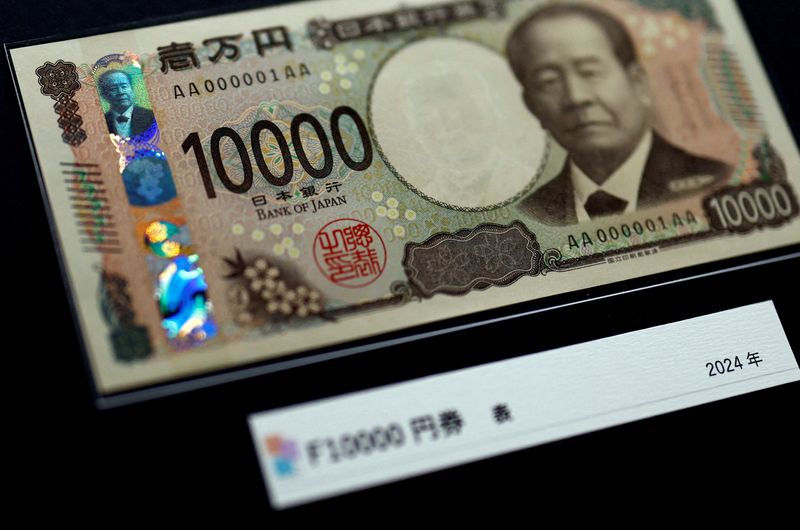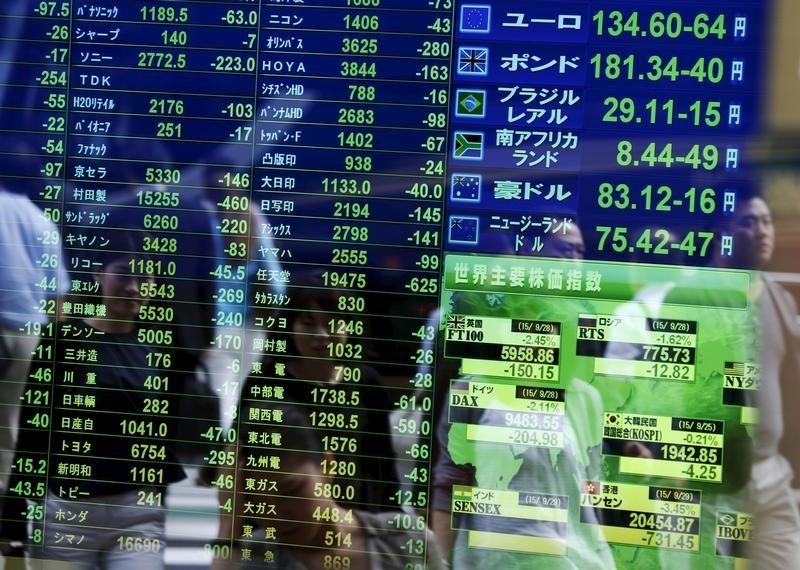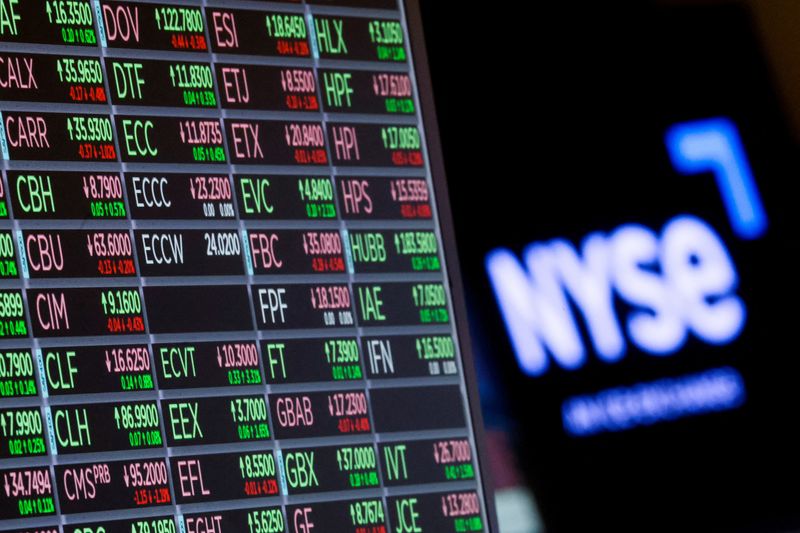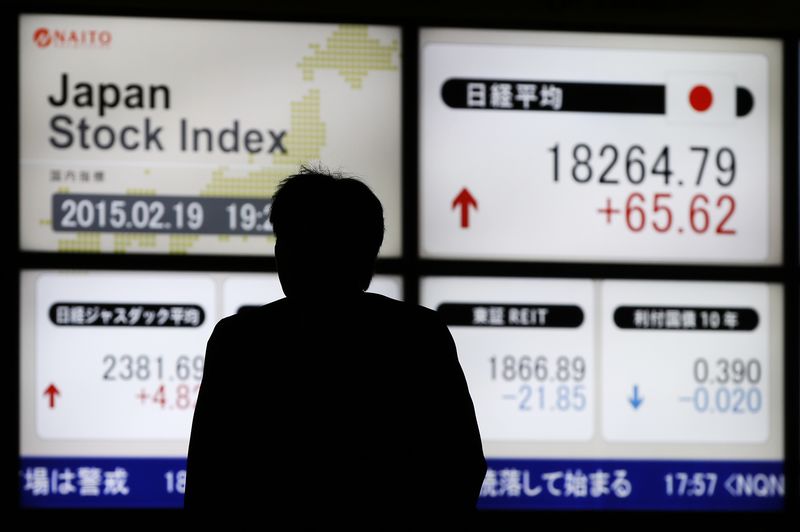Select Language

By Takaya Yamaguchi
TOKYO (Reuters) -Japan's government is set to compile a record $735 billion budget for the fiscal year from April due to larger social security and debt-servicing costs, adding to the industrial world's heaviest debt, a draft seen by Reuters showed.
The 115.5 trillion yen draft budget is being compiled as the Bank of Japan shifts away from its decade-long stimulus programme, putting more burden on the government to stimulate the economy.
In an attempt to improve public finances, however, the government plans to trim new bond issuance next fiscal year to 28.6 trillion yen from this fiscal year's initially planned 35.4 trillion yen, helped by tax revenue growth, the draft showed.
It is the first time in 17 years that new bond issuance will drop below 30 trillion yen.
Decades of stop-start fiscal spending and reform have left Japan with the industrial world's heaviest public debt burden - more than double the size of its annual economic output.
The BOJ's retreat from a decade of radical stimulus adds to pressure on Japan's fiscal health, as the government can no longer count on the central bank to effectively bankroll debt.
The BOJ ended negative interest rates in March and raised its short-term policy target to 0.25% in July. Governor Kazuo Ueda signalled on Wednesday that the next rate hike is nearing, saying wage and price developments indicate the economy will move closer to sustainably achieving the central bank's 2% inflation target next year.
The draft budget, up from this fiscal year's 112.6 trillion yen, is expected to be approved by Prime Minister Shigeru Ishiba's cabinet on Friday for submission to parliament for deliberation early next year.
Tax revenue is projected to rise 8.8 trillion yen from this year's initial estimate to a record 78.4 trillion yen, thanks in part to a recovery in corporate profits, according to the draft.
The primary budget balance, which excludes new bond sales and debt servicing costs, will be in deficit of less than 1 trillion yen, keeping alive the possibility of achieving the government's goal of delivering a primary budget surplus by the next fiscal year.
The budget draft assumes the yield on the benchmark 10-year government bond rises to 2% next fiscal year from this year's 1.9%, topping 2% for the first time in 13 years.
That would boost debt-servicing costs for interest payments and debt redemption to 28.2 trillion yen from 27 trillion yen for this fiscal year.
The government on Wednesday revised its economic outlook, estimating the real economic growth rate for the current fiscal year at 0.4%, down from 0.7% projected in November as a Chinese economic slowdown weighed on exports.
The growth projection for the next fiscal year was kept at 1.2%.
($1 = 157.2200 yen)

By Leika Kihara
TOKYO (Reuters) -Bank of Japan policymakers agreed in October to keep raising interest rates if the economy moves in line with their forecast, but some stressed the need for caution on uncertainty over U.S. economic policy, minutes of the meeting showed on Tuesday.
The debate highlights how overseas economic risks, particularly those surrounding the new U.S. administration's policies, will be key to how soon the BOJ will hike rates.
While the Oct. 30-31 meeting was held before Donald Trump's victory in the Nov. 5 presidential election, BOJ board members warned of renewed market volatility and potential big changes to U.S. policy as key risks to the outlook, the minutes showed.
"We can spend time scrutinising U.S. developments, including those after the U.S. presidential election, as we had already been expecting to raise rates at a moderate pace," one of the members was quoted as saying in the minutes.
Contrary to their concern over external risks, the board was mostly optimistic on domestic economic conditions. Many on the nine-member board said prospects of higher wages would support consumption and keep Japan on track to sustainably hit the BOJ's 2% inflation target, the minutes showed.
"Wage growth is likely to remain elevated in next year's spring wage negotiations" between firms and unions, a few members were quoted as saying.
The BOJ left interest rates steady at 0.25% at the October meeting but projected inflation to move around its 2% target in the coming years, signalling that it was on track to hike borrowing costs in the near-term horizon.
While the board confirmed the view the BOJ would continue to raise rates if its economic and price projections were met, many called for vigilance to various risks, the minutes showed.
"We must guide monetary policy cautiously given heightening uncertainty at home and abroad," one member was quoted as saying in explaining why the BOJ should stand pat in October.
"The BOJ must spend time and be cautious" in deciding when to raise rates as Japan has not seen its policy rate exceed 0.5% for the past three decades, another opinion showed.
The BOJ kept rates unchanged at a subsequent meeting in December to await more data on whether wages would retain their upward momentum next year, and to gain more clarity on U.S. president-elect Donald Trump's policies.
The BOJ ended negative interest rates in March and raised its short-term policy target to 0.25% in July. It has signalled a readiness to hike again if wages and prices move as projected.
All respondents in a Reuters poll taken earlier this month expected the BOJ to raise rates to 0.50% by end-March, although they had been divided on whether the move would come in December, January or March.

(Reuters) - Chinese authorities have agreed to issue 3 trillion yuan ($411 billion) worth of special treasury bonds next year, two sources said, which would be the highest on record, as Beijing ramps up fiscal stimulus to revive a faltering economy.
The plan for 2025 sovereign debt issuance would be a sharp increase from this year's 1 trillion yuan and comes as Beijing prepares to soften the blow from of an expected increase in U.S. tariffs on Chinese imports when Donald Trump returns to the White House in January.
The proceeds will be targeted at boosting consumption via subsidy programmes, equipment upgrades by businesses and funding investments in innovation-driven advanced sectors, among other initiatives, said the sources.
The sources, who have knowledge of the discussions, declined to be named due to sensitivity of the matter.
The State Council Information Office, which handles media queries on behalf of the government, the finance ministry and the National Development and Reform Commission (NDRC), did not immediately respond to a Reuters request for comment.
The planned special treasury bond issuance next year would be the largest on record and underscores Beijing's willingness to go even deeper into debt to counter deflationary forces in the world's second-largest economy.
China does not generally include ultra-long special bonds in its annual budget plans, as it sees the instrument as an extraordinary measure to raise proceeds for specific projects or policy goals as needed.
As part of next year's plan, about 1.3 trillion yuan to be raised through long-term special treasury bonds would fund "two major" and "two new" programmes, said the sources with knowledge of the matter.
The "new" initiatives consist of a subsidy programme for durable goods, where consumers can trade in old cars or appliances and buy new ones at a discount, and a separate one that subsidises large-scale equipment upgrades for businesses.
The "major" programmes refer to projects that implement national strategies such as construction of railways, airports and farmland and build security capacity in key areas, according to official documents.
The state planner NDRC said on Dec. 13 Beijing had fully allocated all proceeds from this year's 1 trillion yuan in ultra-long special treasury bonds, with about 70% of proceeds financing the "two major" projects and the remainder going towards the "two new" schemes.
TARIFFS THREAT
Another big portion of the planned proceeds for next year would be for investments in "new productive forces", Beijing's shorthand for advanced manufacturing, such as electric vehicles, robotics, semiconductors and green energy, the sources said.
One of the sources said the amount earmarked for that initiative would be more than 1 trillion yuan.
The remaining proceeds would be used to recapitalise large state banks, said the sources, as top lenders struggle with shrinking margins, faltering profits and rising bad loans.
The issuance of new special treasury debt next year would equate to 2.4% of the country's 2023 gross domestic product (GDP). Beijing had raised 1.55 trillion yuan via such bonds in 2007, or 5.7% of the country's economic output at that time.
President Xi Jinping and other top officials met at the annual Central Economic Work Conference (CEWC) on Dec. 11-12 to chart the economic course for 2025.
A state media summary of that meeting said it was "necessary to maintain steady economic growth", raise the fiscal deficit ratio and issue more government debt next year, but did not mention specific numbers.
Reuters reported last week, citing sources, that China plans to raise the budget deficit to a record 4% of GDP next year and maintain an economic growth target of around 5%.
At the CEWC, Beijing sets targets for economic growth, the budget deficit, debt issuance and other goals for the year ahead. These targets, usually agreed upon by top officials at the meeting, will not be officially announced until an annual parliament meeting in March and could still change before then.
China's economy has struggled this year due to a severe property crisis, high local government debt and weak consumer demand. Exports, one of the few bright spots, could soon face U.S. tariffs in excess of 60% if Trump delivers on his campaign pledges.
While the risks to exports mean China will need to rely on domestic sources of growth, consumers are feeling less wealthy due to falling property prices and minimal social welfare. Weak household demand also poses a key risk.
Last week, Chinese officials said that Beijing plans to expand the consumer goods and industrial equipment trade-in programmes to include more products and sectors.
($1 = 7.2939 Chinese yuan)

Investing.com-- Most Asian stocks rose on Tuesday, supported by gains in technology stocks as they tracked their U.S. peers, although trading volumes were slim before the Christmas break.
Regional markets took positive cues from Wall Street, which closed higher on Monday as technology stocks recouped some of their steep losses from last week. U.S. stock index futures were flat in Asian trade.
Wall Street will have a shortened trading session on Tuesday, as will most Asian markets.
Asian markets were nursing losses in recent sessions after the Federal Reserve flagged a slower pace of interest rate cuts in 2025- a scenario that bodes poorly for risk-driven assets.
Japan shares muted; Honda rallies, Nissan flat amid merged talk
Japan’s Nikkei 225 index fell slightly on Tuesday, as did the TOPIX.
Focus was squarely on automakers Honda (NYSE:HMC) Motor Co Ltd (TYO:7267) and Nissan Motor Co., Ltd. (TYO:7201), after they confirmed on Monday that they were in talks over a potential merger, which will be completed in 2026.
Honda’s shares rallied as much as 15%, also benefiting from the company announcing a 1.1 trillion yen ($7 billion) buyback.
Nissan (OTC:NSANY), on the other hand, traded flat after recouping a bulk of losses clocked earlier in the session. The stock had risen sharply on Monday after news of the merger first broke.
Mitsubishi Motors (OTC:MMTOF), in which Nissan holds a 34% stake- will also consider joining the merger. Its shares rose 3.6%.
The Honda-Nissan deal will create the world’s third-largest automaker by sales once completed. But analysts noted that a 2026 date for the deal was too cautious, especially given that the automakers were grappling with an extended decline in sales.
Chinese stocks upbeat on stimulus hopes
China’s Shanghai Shenzhen CSI 300 and Shanghai Composite indexes rose around 0.7% each, while gains in tech stocks saw Hong Kong’s Hang Seng index rally 1%.
Markets were holding out for more clarity on Beijing’s plans for stimulus measures in the coming year. Recent reports suggested that the country will ramp up fiscal spending to support economic growth.
Optimism over more stimulus helped Chinese stocks weather a recent downturn in Asian markets. Chinese purchasing managers index data is now due in the coming days and is set to offer more cues on Asia’s largest economy.
Broader Asian stocks were mostly higher in shortened holiday trading. Australia’s ASX 200 added 0.1% as the minutes of the Reserve Bank’s December meeting showed policymakers signaling an eventual decline in interest rates.
South Korea’s KOSPI fell 0.2%, as gains in tech stocks were offset by persistent concerns over political turmoil in the country.
Singapore’s Straits Times Index index rose 0.5%, while futures for India’s Nifty 50 index pointed to a weak open, as the index nursed steep losses over the past few weeks.

Investing.com-- U.S. stock index futures were largely steady on Monday evening after a rally in the world’s largest technology stocks pushed Wall Street higher amid thin trading ahead of the Christmas holiday.
The New York Stock Exchange is set to close early Tuesday for Christmas Eve, and the market is shut on Christmas Day.
S&P 500 Futures were largely unchanged at 6,034.0 points, while Nasdaq 100 Futures edged lower to 21,730.50 points by 19:33 ET (00:33 GMT). Dow Jones Futures were largely steady at 43,324.0 points.
Wall Street recovers from Fed-induced last week's slump
The U.S. Federal Reserve projected fewer-than-expected cuts in 2025 on Wednesday. This had led to sharp falls in all three major indexes and a weekly decline on Wall Street.
The Fed signaled a cautious approach to monetary policy adjustments, emphasizing the need for continued progress on inflation before considering further rate cuts.
Markets scaled back rate cut expectations after the Fed meeting, pricing in just two more cuts in the upcoming year.
Sentiment improved on Friday after (PCE) price index—the Fed’s preferred measure of inflation—rose at a slower-than-expected pace in November, while the rise in core inflation was largely in line with estimates.
Although the recent data indicates a cooling trend, the persistent elevation above the 2% target suggests that inflationary pressures are not yet fully contained.
Chip stocks jump amid broader tech rally, Rumble shares surge
Wall Street indexes closed higher on Monday led by a surge in semiconductor stocks that gave tech a strong start to the holiday-shortened week.

SEOUL (Reuters) - South Korea's consumer sentiment dropped sharply this month to hit the weakest level in more than two years on growing worries about political uncertainty following parliament's impeachment of President Yoon Suk Yeol.
The consumer sentiment index fell to 88.4 in December from 100.7 in November, the lowest since the index hit 86.6 in November 2022, when 159 people were killed in a Halloween crowd crush, the Bank of Korea's monthly survey of consumers showed.
The Composite Consumer Sentiment Index falling below the threshold of 100 means consumers have turned pessimistic over the economy.
Thousands of protesters massed on Seoul's streets as the parliament voted to impeach President Yoon on Dec. 14 over his short-lived declaration of martial law on Dec. 3.
Tuesday's data, the first monthly indicator since the crisis erupted over the martial law decree, shows consumer confidence is fast fraying amid political divisions as constitutional justices are set to weigh up whether to formally remove Yoon.
In the days following Yoon's martial law declaration, the benchmark Kospi plunged while the South Korean won last week hit its weakest level in 15 years.
A sub-index on consumer spending outlook dropped by 7 points as "domestic political uncertainties worsened consumption sentiment across travel spending, dining out expenses and durable goods, which declined by 8 points, 6 points and 3 points, respectively," the BOK said in a statement.
Governor Rhee Chang-yong on Dec. 18 also said the political turmoil is weighing on the South Korean economy, and called for more fiscal support and other measures to ensure growth remains intact.

By Bing Hong Lok
SINGAPORE (Reuters) - Singapore's key consumer price gauge rose 1.9% in November on a yearly basis, lower than economists' forecasts and the smallest rise in nearly three years, official data showed on Monday.
The core inflation rate - which excludes private road transport and accommodation costs - was lower than the 2.1% forecast by a Reuters poll of economists and compared with a 2.1% rise seen in October.
It was the smallest rise since November 2021, when it climbed by 1.6%.
Headline inflation was 1.6% in annual terms in November, lower than the 1.8% expected in the poll.
The Monetary Authority of Singapore had forecast core inflation to be around 2% in the fourth quarter.
Slowing inflation has created room for Singapore's central bank to ease monetary policy in January but analysts have said the MAS might wait until later in 2025 on the back of incoming U.S. President Donald Trump's policies.
The MAS left monetary policy settings unchanged in October even as growth picked up and inflation declined. It has not changed policy since a tightening in October 2022, which was the fifth tightening in a row.
Last month, the trade ministry raised its GDP growth forecast for 2024 to 3.5% from a previous range of 2.0% to 3.0%, after third-quarter growth surpassed expectations at 5.4%.
Most economists polled in a MAS survey released recently expect the MAS to maintain its current monetary policy in its quarterly reviews in January, April and July.
A third of those polled in the MAS survey expected a January easing via a reduction in the slope of the Singapore dollar nominal effective exchange rate, down from half in the previous survey.

By Simon Robinson
(Reuters) - Inflation dropped in most economies around the world in 2024, but voters didn’t care.
Angered by the hefty ramp-up in prices for everything from eggs to energy over the past few years, they punished incumbent parties at almost every opportunity. The pain of inflation lingers, and ruling parties took the blame in election after election.
In the United States, higher costs helped Donald Trump win a second term as president four years after he was voted out of the White House and then falsely claimed election fraud. His supporters failed in their bid to overturn Trump's defeat by storming the U.S. Capitol on Jan. 6, 2021. This year, they made their voices heard at the ballot box, ushering in a new American leadership likely to test democratic institutions at home and relations abroad.
The inflation-driven anti-incumbent sentiment also ushered in new governments in Britain and Botswana, Portugal and Panama. South Korean voters put the opposition into power in its parliament, a check on President Yoon Suk Yeol. In early December, the president imposed martial law, a move the National Assembly quickly reversed. Elections also shook up France and Germany, and Japan and India.
One place there was no change: Russia, where Vladimir Putin was re-elected president with 88% of the vote, a record in post-Soviet Russia.
Moscow continued to prosecute its war against Ukraine, grinding out notable territorial gains. The big question is what impact Trump’s return to the White House will have on the conflict. He has promised to end the war in a day. Many in Ukraine and elsewhere in Europe fear that will mean siding with Putin and freezing the status quo.
In the Middle East, Israel continued its war against Gaza and extended it to Lebanon, where it left Iran-backed Hezbollah damaged and in disarray. In Syria, a well-coordinated collection of rebel groups toppled Bashar al-Assad and now seeks to run the country.
In business, companies around the world grappled with how to adapt to artificial intelligence. The dominance of tech companies for investors can be summed up in this simple fact: seven tech firms — the so-called Magnificent Seven — now account for more than one-third of the S&P 500’s market cap.
Elon Musk, who runs one of those companies, Tesla (NASDAQ:TSLA), is an adviser and financial backer to President-elect Trump. Looking ahead, that combination of tech bro mojo and political power could well define 2025.

nvesting.com-- Most Asian stocks rose on Monday, tracking gains in Wall Street after softer U.S. inflation data spurred bets that interest rates will still fall in the coming year.
Japanese stocks were among the better performers for the day, buoyed by speculation over a potential merger between Honda (NYSE:HMC) and Nissan (OTC:NSANY), as reports said a deal was close.
Regional markets took positive cues from Wall Street, which surged on Friday after PCE price index data- the Federal Reserve’s preferred inflation gauge- read softer than expected for November. The reading helped ease some concerns that U.S. rates will fall at a slower pace in 2025, especially after the Fed struck a hawkish tone during a meeting last week.
U.S. stock futures rose in Asian trade, also supported by optimism over the U.S. government avoiding a shutdown.
Japanese shares rise amid Honda-Nissan merger reports
Japan’s Nikkei 225 and TOPIX indexes rose 0.9% and 0.5%, respectively.
Gains in Japanese markets came amid increased focus on Honda Motor Co Ltd (TYO:7267) and Nissan Motor Co., Ltd. (TYO:7201), after a report from public broadcaster NHK said a preliminary agreement will be signed later on Monday, with the goal of finalizing merger terms by June 2025.
Honda rose nearly 2%, while Nissan fell slightly after rallying about 20% last week. Mitsubishi Motors Corp. (TYO:7211), which could also be pulled into the merger, rose 2.8%.
The merger has the potential to create the third-largest global automaker by sales, and is being considered as Honda and Nissan grapple with increased competition and softening sales, especially in top auto market China.
Beyond speculation over the merger, focus in Japanese markets was also on key inflation data for November released on Friday. The reading showed inflation picked up more than expected in November, keeping expectations of interest rate hikes by the Bank of Japan squarely in play.
Asia stocks rise with focus on US rates, China stimulus
Broader Asian markets advanced on Monday amid optimism over softer U.S. inflation, although most regional markets were still nursing losses from the prior week.
Australia’s ASX 200 rose 1.2%, with local shares of News Corp (ASX:NWS) (NASDAQ:NWSA) rising 2.2% after after the firm said it will sell television broadcaster Foxtel to British sports streamer DAZN Group in a A$3.4 billion ($2.1 billion) deal.
China’s Shanghai Shenzhen CSI 300 and Shanghai Composite indexes rose 0.6% and 0.2%, respectively, while Hong Kong’s Hang Seng index added 0.5%.
Chinese markets were sitting on some gains in recent sessions after Beijing offered up more assurances that it will ramp up fiscal spending in 2025 to support economic growth.
South Korea’s KOSPI added 1.5% and was the best performer in the region, as investors bought into heavily discounted stocks after local markets were walloped by heightened political uncertainty earlier this month.
Singapore’s Straits Times Index rose 1.1%, with Talkmed Group Ltd (SGX:TALK) rallying nearly 6% after receiving an offer to be taken private.
Singapore Post Ltd (SGX:SPOS) slid 8% after it fired its CEO Phang Heng Wee over alleged misconduct.
Futures for India’s Nifty 50 index pointed to a slightly positive open, after the index fell sharply through the prior week.

By Gram Slattery
WEST PALM BEACH, Florida (Reuters) -President-elect Donald Trump threatened to reassert U.S. control over the Panama Canal on Sunday, accusing Panama of charging excessive rates to use the Central American passage and drawing a sharp rebuke from Panamanian President Jose Raul Mulino.
Speaking to a crowd of supporters in Arizona, Trump also said he would not let the canal fall into the "wrong hands," warning of potential Chinese influence on the passage.
After the event, he posted an image on Truth Social of an American flag flying over a narrow body of water, with the comment: "Welcome to the United States Canal!"
"Has anyone ever heard of the Panama Canal?" Trump said at AmericaFest, an annual event organized by Turning Point, an allied conservative group. "Because we're being ripped off at the Panama Canal like we're being ripped off everywhere else."
Trump's comments were an exceedingly rare example of a U.S. leader saying he could push a sovereign country to hand over territory. They also underlined an expected shift in U.S. diplomacy under Trump, who has not historically shied away from threatening allies and using bellicose rhetoric when dealing with counterparts.
"It was given to Panama and the people of Panama, but it has provisions," Trump said of the canal, which was once owned by the United States but was handed over to Panama decades ago.
"If the principles, both moral and legal, of this magnanimous gesture of giving are not followed, then we will demand that the Panama Canal be returned to us, in full, quickly and without question."

